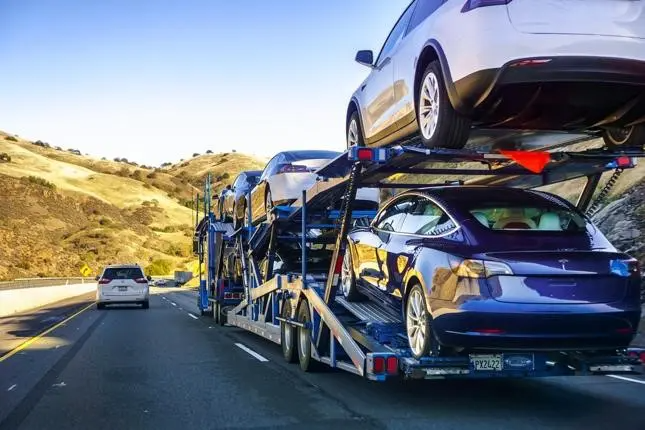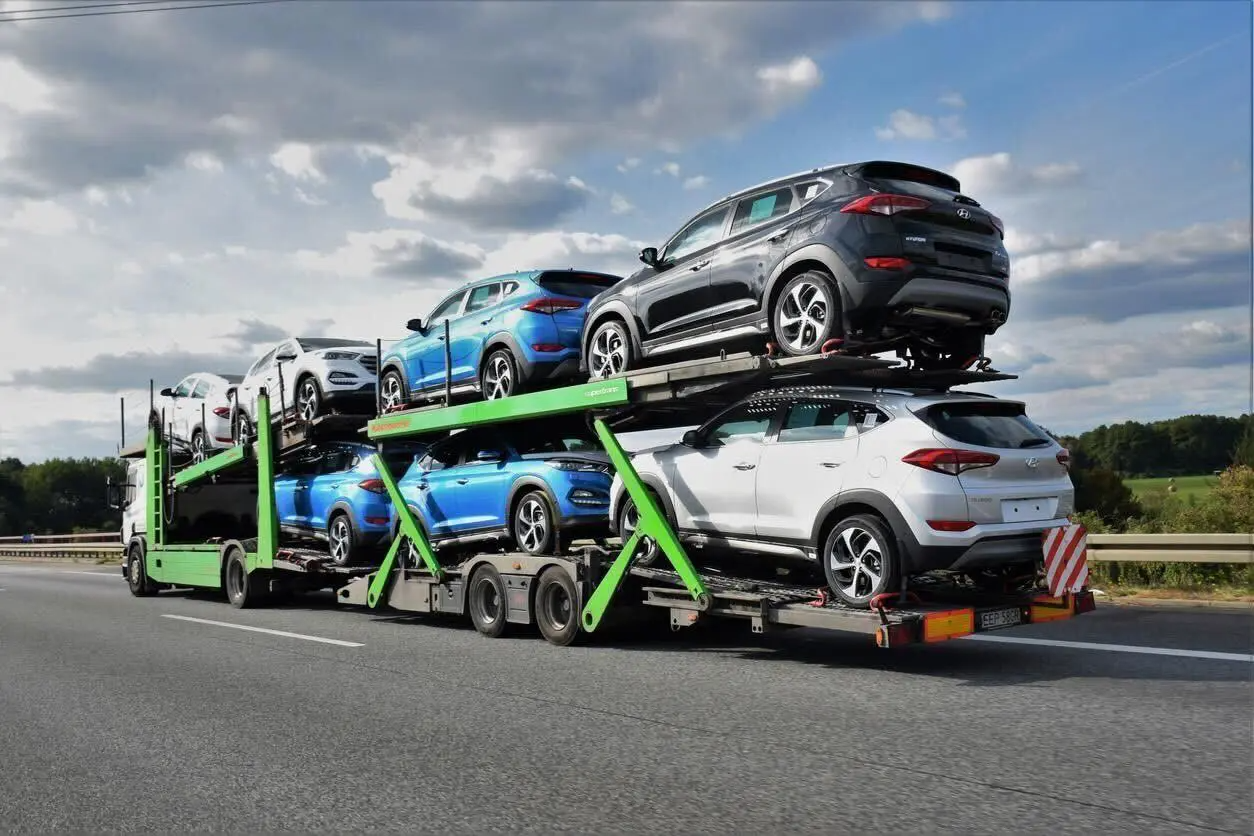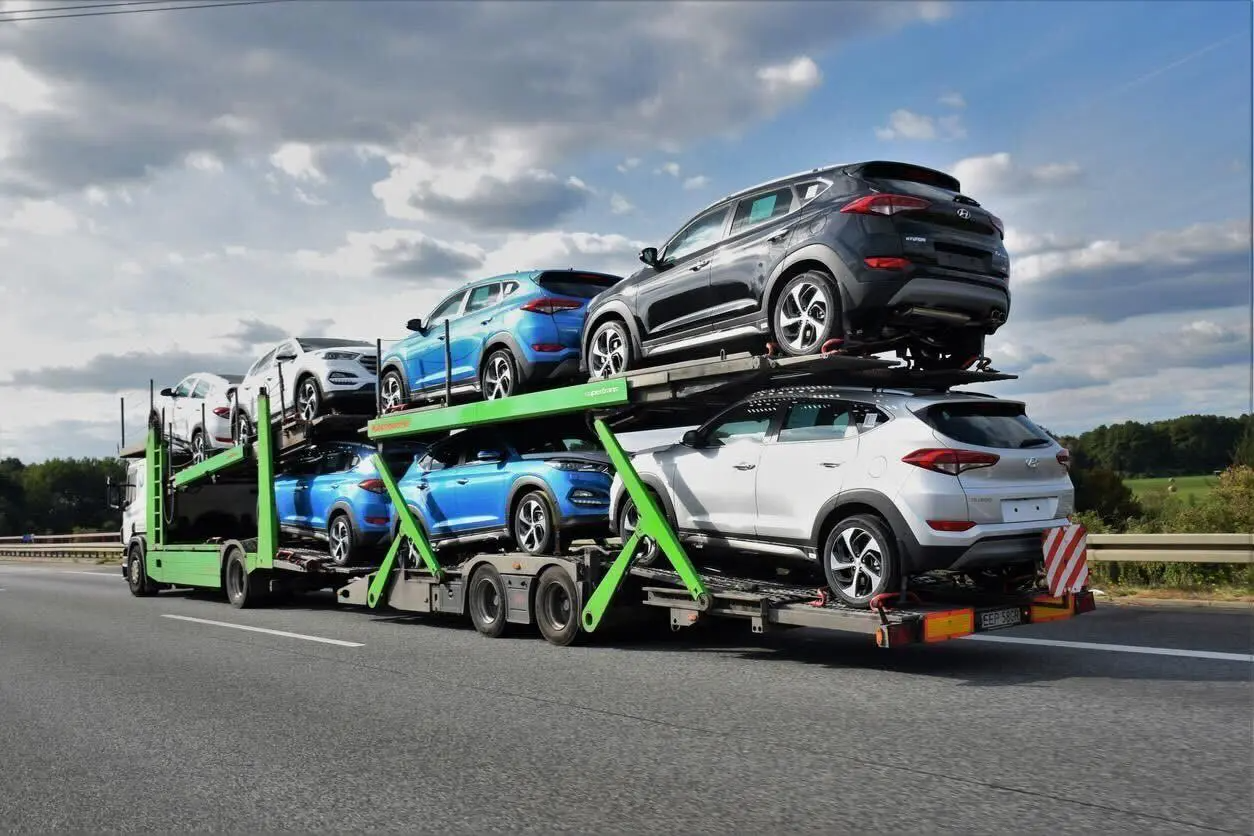Yes and no. The strict interpretation is no, you can’t ship items inside your vehicle. The reality is that almost all carriers look the other way on items that weigh less than 100 pounds, roughly the equivalent of 2 suitcases. We recommend placing any additional items in the trunk and out of sight. The U.S. Transportation Law states that a carrier can be fined $10,000 for hauling household items in the vehicle, but it’s rarely enforced. However, the drivers do estimate the weight of each vehicle that they carry and don’t want problems at weight scales. So they must keep the personal items to a minimum. Some drivers will accept a tip ($50-$250) for hauling extra stuff, but some won’t. Rule of thumb, don’t take advantage. The driver is there to ship a car, not move the owner’s belongings. Our vehicle transport cost calculator will not add an extra charge for additional items because it would be presumptuous of us to expect the driver to do it. If you want to add items to your vehicle, discuss it with the driver.
Frequently Asked Questions

See Why People Prefer
Direct Express Auto Transport



How Far In Advance Should You Set Up Your Car Shipping Order?

We recommend scheduling your auto transport anywhere from two days to two weeks in advance. We are often able to ship your car on the very same day, but providing us with a longer lead time allows us to schedule your vehicle transport better. You want the most current pricing, and you get that by staying within two weeks of your first available date to ship.
Believe it or not, a request of $50-$75 too low can really hold up your order if there are plenty of other cars available to ship at the higher pricing. To avoid that, try not to book more than a month in advance and preferably within two weeks, because seasonal changes can impact the current pricing. Conversely, you should enjoy the savings if the rates were to go down, so having the most current pricing is always best.
Should You Ship Your Car Open or Enclosed?

Is It Better To Pay An Auto Transport Deposit?

If You Are Car Shipping To Yourself, How Do You Figure Out When To Make Your Car Available?
This is one of the trickier questions in car shipping, because it’s almost impossible not to be inconvenienced at one end or the other when shipping a car to yourself. Establishing a support system of friends and family who can assist you in this process is essential, and we recommend you alert them to your schedule and find out who will be able to transport you during the time that your vehicle is unavailable.
Let us know who will be driving you and when, so we can help coordinate the process. If your support system is at the shipping origin, then keep your car available until you begin traveling via plane or bus. Tell us who your contact person is, including address and cell phone number. Make your car available around the time you leave. That doesn’t mean it will get picked up right away because there might not be a car carrier ready the day that you leave. Indeed, it could be another few days or even several days (if you’re in a remote location) before a carrier is in the area to make that run. Wherever you are going, rent a car, or use a ride-sharing service until yours arrives.
A good rule of thumb is to estimate that once your vehicle is picked up, the carrier will travel 500 miles per day. So depending on the distance you may be without your personal car for several days or weeks. We encourage our customers to plan accordingly. If your support system is at the shipping destination, you are frankly under more pressure. You don’t want the stress of waiting until the last minute only to find out there is not a carrier ready to load and get on the road when you fly out. So give yourself time, especially if in a remote location.

How Long Will It Take To Pick Up My Vehicle?

Over 90% of our orders ship inside of one week. That could be anywhere from 1 to 7 days. Most of the U.S. population lives in a major metropolitan area and is shipping to another well populated area, and that makes a big difference. Cars usually ship in a very regular manner, almost half within just a few days.
If either your origination or destination locations are away from population centers, in other words, in a remote area, then you might consider meeting a driver in a nearby big city or town to increase your chances of shipping timely. Or adding money to the carrier fee may entice a carrier. Remember, anyone you choose can serve as your point of contact, which takes the stress out of shipping your vehicle.
How Long Does It Take To Deliver My Vehicle?
Delivering your car is the final step in the process, and also the simplest part. Once your vehicle has been assigned and picked up, not too much can go wrong. After your vehicle is picked up, you can estimate that it will take roughly one day of transit time for every 500 miles distance.
Delivery Time Estimate Guide
100-500 miles takes 1 or 2 days
500-1000 miles takes 2 or 3 days
1000-1500 miles takes 3 or 4 days
1500-2000 miles takes 4 or 5 days
2000-2500 miles takes 5 or 6 days
2500-3000 miles takes 6 or 7 days
Depending on the distance, weather conditions and population centers it could be a few days or weeks until a vehicle reaches its destination. The carriers will usually estimate about 10 days on coast to coast trips, but they frequently arrive earlier.

Is My Vehicle Insured And What Paperwork Can I Expect?

Yes your vehicle is insured. It is our job to make sure that is so. But it is especially wise to maintain your own automobile insurance too.
We automatically and instantly email you an Order Confirmation explaining the whole process upon entering your order either online or with one of our representatives. Once your vehicle is Assigned, it usually gets picked up within a day or two (sometimes same day) of the assignment. That information also gets automatically emailed to you.
Then our driver calls your pickup contact. When the driver picks up your vehicle for shipping, he will do a detailed examination on the Bill of Lading and Vehicle Inspection Report. You will both sign that form and you should receive a copy. The driver will call again from the road, this time your destination contact, as he gets closer so as to schedule an approximate time for delivery.
The Bill of Lading and Vehicle Inspection Report will be there upon delivery so that your contact can re-inspect the car. Your vehicle will be likely dirty from the road, but otherwise should still be in the same condition that it left. The auto transport driver will take every precaution to deliver your vehicle without incident.
How Do I Prepare My Vehicle For Shipment?
Clean out your vehicle of all loose items as much as possible. Leave nothing of value in the vehicle. It’s very rare that any items are stolen during transport, but we recommend extra caution to prevent loss.
Keep extra items as previously discussed to a minimum and place in the trunk or out of sight. Have only about a quarter tank of gasoline. Give the auto transport carrier a set of keys and advise them of any special instructions for your vehicle, like difficulty starting, steering, braking, etc.
Driver Consideration: Being a truck driver can be a thankless job. They work long hours and are away from their families for weeks at a time. Please be friendly and considerate to our drivers, and they will treat you in the same manner.

When I Ship My Car, Can I Put Stuff In It?
Yes and no. The strict D.O.T. interpretation is no, you can’t ship items inside your vehicle. The reality is that almost all carriers look the other way on items that weigh less than 100 pounds, roughly the equivalent of 2 suitcases.
We recommend placing any additional items in the trunk and out of sight. The U.S. Transportation Law states that a carrier can be fined $10,000 for hauling household items in the vehicle, but it’s rarely enforced. However, the drivers do estimate the weight of each vehicle that they carry and don’t want problems at weight scales. So they must keep the personal items to a minimum.
Some drivers will accept a tip ($50-$250) for hauling extra stuff, but some won’t. Rule of thumb, don’t take advantage. The driver is there to ship a car, not move the owner’s belongings. Our vehicle transport cost calculator will not add an extra charge for additional items because it would be presumptuous of us to expect the driver to do it. If you want to add items to your vehicle, please discuss it with the driver.
The distance between origination and destination is probably the main factor determining how much it costs to ship a car. Kind of obvious, right? Philadelphia to Boston is going to cost a lot less than Philadelphia to Los Angeles. The price per mile typically goes down the farther the distance, but the overall cost goes up none the less. The higher the number of miles on the route, the higher the car shipping cost.
The length of a vehicle affects the car transport quote. The average sedan is about 192 inches long. Longer vehicles, especially over 196 inches, start to squeeze an auto transport trailer. Vehicles over 200 inches are more costly to ship because they may inhibit space for another vehicle. Instead of able to carry ten vehicles, a car mover might only be able to accommodate nine. So the longer vehicles need to pay for intruding on that space. These are things that the average customer doesn’t think about, but are a major concern for car shipping companies.
The vehicle height also matters. It works the same way as length. Most sedans are about 57 inches high, midsize SUVs 67 inches, and the larger SUVs are about 73 inches. By and large, all those work fine in most situations. However, the extra tall SUVs, Pickup trucks, and Vans ranging from 75 to 79 inches, are pushing the limits of an auto transporter. What happens is that vehicles 80 inches or higher basically eliminate the option to fit even a small car above it. So the vehicles over 80 inches must pay for two spots.
For a car transport company, every trip is a puzzle piece to be put together just right. It is a combination of mathematics, spatial awareness, creativity, common sense and skill.
Instead of able to carry ten vehicles, a car mover might only be able to accommodate nine. So the longer vehicles need to pay for intruding on that space. These are things that the average customer doesn’t think about, but are a major concern for car shipping companies.
The lower the vehicle ground clearance, the more prone to scrapping the bottom or damaging the bumper, especially when shipping Open carrier. Enclosed car transporters are better equipped to safely handle low ground clearance vehicles. As a general rule, vehicles with above 5 inches of ground clearance are probably safe to go Open car transport. Anything with a ground clearance of 4 inches or less, however, should probably ship Enclosed. If your vehicle is between 4 to 5 inches ground clearance, it’s a judgement call. Most every Open car transport service will think twice about hauling a vehicle with only 4.5 inches ground clearance. That is why it may take longer.
Auto transporters must get through the weight scales like every other freight company. The maximum weight for a truck on a U.S. interstate is 80,000 pounds. Subtracting the weight of the truck and empty trailer, that leaves approximately 45,000 lbs. for cargo, in this case vehicles. Assuming ten vehicles will fit on such a big car hauler, the average weight for each can be no more than 4,500 lbs.. It becomes a puzzle piece on weight too. The lighter vehicles will allow for more heavier vehicles.
Over the decades, Americans especially have gravitated to heavier SUV’s and Pickup trucks. Car shipping cost has risen as a result. It is also for this reason that auto transporters limit extra items placed in the vehicle. It is due to a concern for overall weight.
Maneuvering non-operational vehicles on and off a car transport trailer is a big challenge. Car shipping companies much prefer operational (running) vehicles because it gives them an easier option to reposition their entire load. Non-running vehicles take considerably more time to get on and off the trailer. So the car shipping quote must reflect the higher cost. Many auto transporters don’t have a winch and cannot accommodate non-running vehicles. That is one reason it takes longer on average to ship non-operational vehicles. Fewer do it. If at all possible, fixing your vehicle before trying to ship it will save on the non-running car transport cost, and make the process go faster.
Open car transport means the vehicle will be exposed to the elements, such as weather and the road. Enclosed car shipping is the opposite, as the vehicle is protected from the elements. The average auto transport cost is about 50% higher for Enclosed over Open carrier. That is partly because Enclosed carriers can fit about 50% fewer vehicles while incurring about the same expense, but also because of the extra care and protection.
It should be noted that roughly 97% of all car shipments are Open carrier, which is more cost effective, and also very safe. In either choice, Open or Enclosed carrier, damage complaints are less than 1% of all shipments, and those incidents are relatively innocuous. Enclosed auto shipping is often the choice for high priced, luxury, or collector cars.
The economic laws of supply and demand are at work in the auto transport industry too. Seasonal fluctuations have a major affect on car shipping cost. Summer time is easier and less costly than winter time in the north. Some regions like Florida have seasonal spikes in traffic that make one direction far more expensive, and the reverse direction far cheaper. Even the possibility of inclement weather can greatly affect both the transport cost and service.
A typical year will start with a backlog of vehicles in January, as the number waiting to ship nearly doubles, because car transport carriers stay home for about ten days over the Christmas and New Years holidays. Auto transport quotes rise significantly in a classic over demand vs. under supply equation.
It takes three weeks, or until late January, for equilibrium to return. The vehicle shipping market stays soft in February and March, until April, when the Florida Snowbirds return to the northern states. The same thing happens in other warm weather states, such as California, Texas, Arizona and New Mexico, which continues busy through all of May.
The Summer is exceptionally strong everywhere. It reaches a fever pitch for about two weeks surrounding the 4th of July, as again many carriers stay home, and car transport costs rise. It takes until late July to settle down. August and September are moderately busy with college students shipping their cars. Then October, November and early December tend to be much slower. Auto transport quotes go down.
But come late December the holidays return, the Snowbirds head south to the warmer states, and the ensuing backlog causes auto transport pricing to spike again. And so it goes …
Location also has a big affect on how quickly a vehicle will be shipped. If either the origination or destination are remote or have small populations, it shouldn’t surprise anyone that there is less truck traffic and car shipments may take longer and cost more to attract a carrier. Conversely, according to the 2020 United States Census, roughly 80% of the U.S. population lives in major urban areas, which makes it much easier for car transporters to amalgamate full loads and get on the road quicker. Urban areas typically cost less than remote locations.
A good example is in Michigan. Car shipping to San Francisco from Detroit might take just a few days to assign a carrier. But from somewhat remote Grand Rapids, it could be twice as long. Harder still would be from very remote Traverse City, where up north it could be many weeks before a carrier is heading to San Francisco. Depending on location, a customer should have realistic expectations and plan ahead. Going with the Expedited or Rush tiers help enormously to speed things up.
Making a nominal partial payment is preferred by carriers but not essential. Carriers like getting paid with Cash or Money Order upon delivery, and who doesn’t? A partial credit card payment and balance due upon delivery accomplishes that. But a full credit card payment upfront also works if the carrier trusts the broker. Carriers have known Direct Express Auto Transport for nearly twenty years and the trust is there. So either method works with us.
This is one of the trickier questions in car shipping, because it’s almost impossible not to be inconvenienced at one end or the other when shipping a car to yourself. Establishing a support system of friends and family who can assist you in this process is essential, and we recommend you alert them to your schedule and find out who will be able to transport you during the time that your vehicle is unavailable. Let us know who will be driving you and when, so we can help coordinate the process. If your support system is at the shipping origin, then keep your car available until you begin traveling via plane or bus. Tell us who your contact person is, including address and cell phone number. Make your car available around the time you leave. That doesn’t mean it will get picked up right away because there might not be a car carrier ready the day that you leave. Indeed, it could be another few days or even several days (if you’re in a remote location) before a carrier is in the area to make that run. Wherever you are going, rent a car, or use a ride-sharing service until yours arrives. A good rule of thumb is to estimate that once your vehicle is picked up, the carrier will travel 500 miles per day. So depending on the distance you may be without your personal car for several days or weeks. We encourage our customers to plan accordingly. If your support system is at the shipping destination, you are frankly under more pressure. You don’t want the stress of waiting until the last minute only to find out there is not a carrier ready to load and get on the road when you fly out. So give yourself time, especially if in a remote location. Rule of thumb, make your vehicle available at least one or two weeks ahead of when you are scheduled to leave. After all, you have people at the destination that will receive it anytime. But you must get it moving before you do. Our car shipping quotes calculator does a very good job at setting the price to be successful 90% of the time within one week. But you should consider expediting your order $50, $100 or $200 depending upon your sense of hurry and urgency. You can do that yourself online or call us at 800-600-3750 to perform that task.
Over 90% of our orders ship inside of one week. That could be anywhere from 1 to 7 days. Most of the U.S. population lives in a major metropolitan area and is shipping to another well populated area, and that makes a big difference. Cars usually ship in a very regular manner, almost half within just a few days. If either your origination or destination locations are away from population centers, in other words in a remote area, then you might consider meeting a driver in a nearby big city or town to increase your chances of shipping timely. Remember, anyone you choose can serve as your point of contact, which takes the stress out of shipping your vehicle.
Delivering is final step in the process, and also the simplest part. Once your vehicle has been assigned and picked up, not too much can go wrong. Once the vehicle is picked up, you can estimate that it will take roughly 1 day of transit time for every 500 miles distance. Delivery Time Estimate Guide 100-500 miles takes 1 or 2 days 500-1000 miles takes 2 or 3 days 1000-1500 miles takes 3 or 4 days 1500-2000 miles takes 4 or 5 days 2000-2500 miles takes 5 or 6 days 2500-3000 miles takes 6 or 7 days Depending on the distance, weather conditions and population centers it could be a few days or weeks until a vehicle reaches its destination. The carriers usually estimate about 10 days on coast to coast trips, but they frequently arrive earlier.
Reviews From Our Customers
-
My Auto Transport Experience
Nancy B. – Orlando, FLI am so pleased with my decision to use Direct Express Auto Transport! Ashley was a knowledgeable and confidence inspiring representative and my driver was on time and my car was in perfect shape!
-
Great Auto Transport Service To Texas
Steve S. – New Braunfels, TXTalked to Jessica on Wednesday to have 65 El Camino shipped from Calif to Texas. Was picked up on Thursday the 16th and delivered on Monday the 20th. Beautiful truck and great driver. Sebastian was the driver’s name. Also it was awesome to see all the other great cars.
-
Enclosed Auto Transport
Derek K. – Oradell, NJFantastic experience all around, from the office people calling me back on a Sunday when a question popped up, to getting the car delivered very quickly, the whole process went perfectly. Will use them again for sure.
-
My Car Arrived Sooner Than Expected!
Charlie R. – Mt Clemons, MIDriver was very efficient and accommodating! Once he picked up the vehicle he stayed in contact with us all the way to delivery. Thank you very much for hauling this vehicle for us because we have no way of doing it ourselves.
-
Auto Transport From Florida
Alicia L. – Bradenton, FLMy car was picked up on a Friday morning and arrived at my destination two days later. The driver made sure that I was on time delivering my car and he made sure my car was delivered to me in a timely manner also. Great customer service from beginning to end. No complaints at all and will definitely use this company again. Great job!
-
Auto Transport Service To Arizona
Jeff B. – Mesa, AZAnother excellent job by Direct Express Auto Transport! This is the 3rd time we’ve shipped with this Direct Express Auto Transport. They’re courteous, professional, and on time. I highly recommend this company and their services!
-
Car Transported California to Texas
Bill A. – Ft. Worth, TXI used the expedited shipping option and they told me it will be picked up within 3-4days. Luckily my car was picked up on the very first day. It was assigned to one of their transport companies and I received my car within 10days. They are very professional.